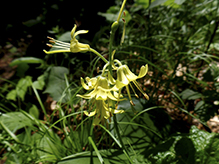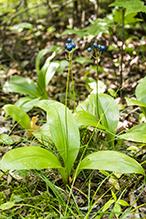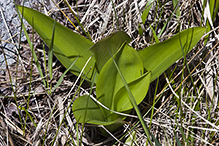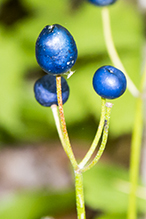bluebead lily
(Clintonia borealis)
Conservation • Wetland • Description • Habitat • Ecology • Use • Distribution • Taxonomy
Description |
||
Bluebead lily is a perennial forb that rises on a rosette of basal leaves and a leafless flowering stalk from a thin spreading rhizome with thin fibrous roots. There are usually 2 or 3 basal leaves, occasionally 4 or 5. The leaves are stalkless, oblong to elliptic or inversely egg-shaped, 6″ to 12″ long, and 2″ to 3″ wide. They sheath the scape at the base and taper abruptly to a sharp point at the tip with concave sides along the tip. The upper surface is dark green and glossy. The margins are untoothed and have a fringe of hairs. The flowering stalk (scape) is 6″ to 16″ tall, erect, unbranched, and hairy, at least when young. The inflorescence is an unbranched cluster (raceme) of 3 to 8 flowers at the end of the scape. The flowers nod at the end of a ⅜″ to 1¼″ long stalk (pedicel). The pedicels are covered with soft hairs. Each flower is about ⅝″ long. There are 3 petals and 3 petal-like sepals (tepals), 6 stamens, and 1 style. The tepals are yellowish-green, narrowly oblong, ½″ to ⅝″ long, and ⅛″ to 3 ⁄16″ wide. The stamens have slender, ½″ to ⅝″ long filaments and oblong, 1 ⁄16″ to ⅛″ long anthers. The pedicels become erect in fruit. The fruit is an dark blue, egg-shaped, 5 ⁄16″ to ½″ in diameter berry with a few to several seeds. It ripens in mid-summer. |
||
Height |
||
6″ to 16″ |
||
Flower Color |
||
Greenish-yellow |
||
Similar Species |
||
Habitat |
||
Moderate moisture to moist. Coniferous, deciduous, or mixed woods; wooded bogs; swamps. Full shade. |
||
Ecology |
||
Flowering |
||
Early May to early July |
||
Pests and Diseases |
||
|
||
Use |
||
|
||
Distribution |
||||
|
Sources |
|||
| 2/25/2023 | ||||
Nativity |
||||
Native |
||||
Occurrence |
||||
Common |
||||
Taxonomy |
|||
| Kingdom | Plantae (Plants) | ||
| Division | Tracheophyta (Vascular Plants) | ||
| Subdivision | Spermatophytina (Seed Plants) | ||
| Class | Liliopsida (Monocots) | ||
Order |
Liliales (lilies, supplejacks, and allies) | ||
Family |
Liliaceae (lilies) | ||
| Subfamily | Lilioideae | ||
| Tribe | Medeoleae (cead lilies and cucumber roots) | ||
Genus |
Clintonia (bead lilies) | ||
The genus Clintonia was formerly placed in the subfamily Medeoloideae. That subfamily has recently been downgraded to tribe status with the name Medeoleae. |
|||
Synonyms |
|||
Dracaena borealis |
|||
Common Names |
|||
blue-bead-lily bluebead bluebead lily bluebead-lily Clinton lily Clinton’s lily corn-lily yellow blue-bead-lily yellow clintonia |
|||
Glossary
Filament
On plants: The thread-like stalk of a stamen which supports the anther. On Lepidoptera: One of a pair of long, thin, fleshy extensions extending from the thorax, and sometimes also from the abdomen, of a caterpillar.
Pedicel
On plants: the stalk of a single flower in a cluster of flowers. On insects: the second segment of the antennae. On Hymenoptera and Araneae: the narrow stalk connecting the thorax to the abdomen: the preferred term is petiole.
Raceme
An unbranched, elongated inflorescence with stalked flowers. The flowers mature from the bottom up.
Rhizome
A horizontal, usually underground stem. It serves as a reproductive structure, producing roots below and shoots above at the nodes.
Scape
An erect, leafless stalk growing from the rootstock and supporting a flower or a flower cluster.
Tepal
Refers to both the petals and the sepals of a flower when they are similar in appearance and difficult to tell apart. Tepals are common in lilies and tulips.
Visitor Photos |
|||||
Share your photo of this plant. |
|||||
| This button not working for you? Simply email us at info@MinnesotaSeasons.com. Attach one or more photos and, if you like, a caption. |
|||||
Kathy Ross |
|||||
 |
|||||
Luciearl |
|||||
Only saw one of these a few years ago, but this year found a couple of large patches. |
|||||
 |
 |
||||
MinnesotaSeasons.com Photos |
|||||
Fruiting Plant |
|||||
 |
 |
||||
 |
|||||
Unfurling Leaves |
|||||
 |
 |
||||
 |
|||||
Inflorescence |
|||||
 |
 |
||||
Infructescence |
|||||
 |
 |
||||
Plant with Two Basal Leaves |
|||||
 |
|||||
Plant with Three Basal Leaves |
|||||
 |
 |
||||
Plant with Four Basal Leaves |
|||||
 |
|||||

Slideshows |
||
| Bluebead Lily Andree Reno Sanborn |
||

|
||
About
Clintonia borealis |
||
| Clintonia borealis (Bluebead Lily) Allen Chartier |
||

|
||

Visitor Videos |
|||
Share your video of this plant. |
|||
| This button not working for you? Simply email us at info@MinnesotaSeasons.com. Attach a video, a YouTube link, or a cloud storage link. |
|||
Other Videos |
|||
| Yarrow and Yellow Clintonia ironDsteele |
|||
About
Published on May 20, 2015 Part 11 in an ongoing series of documentaries on wild edible, medicinal, and toxic plants. I'm covering the highly medicinal "Yarrow" (Achillea millefolium) and the tender edible "Yellow Clintonia" (Clintonia borealis). All video footage is recorded by me on the GoPRO Hero 4 Silver Edition. Some of the pictures taken from reputable sources on the internet. Click 5:45 to skip to Yellow Clintonia. |
|||
| Wild Edibles: Clintonia (corn lily) JoeandZachSurvival |
|||
About
Uploaded on Aug 13, 2011 In this video we identify and talk about what is and is not edible on this common forest floor plant. |
|||
| MyNature Apps; Identifying Yellow Clintonia,Clintonia borealis MyNatureApps |
|||
About
Uploaded on May 30, 2011 How to identify Yellow Clintonia, Clintonia borealis also know as Yellow Corn-lily or Blue-bead. www.mynatureapps.com |
|||
| Edible and Inedible! Bluebead Lily karlsefni01 |
|||
About
Uploaded on Jul 21, 2009 Common throughout eastern North America, the Bluebead Lily has both edible and inedible parts. |
|||

Visitor Sightings |
|||||
Report a sighting of this plant. |
|||||
| This button not working for you? Simply email us at info@MinnesotaSeasons.com. Be sure to include a location. |
|||||
| Kathy Ross 6/21/2023 |
Location: Temperance River State Park |
 |
|||
| Luciearl 6/2/2018 |
Location: Fairview Township, MN Only saw one of these a few years ago, but this year found a couple of large patches. |
 |
|||
MinnesotaSeasons.com Sightings |
|||||

|
Created: Last Updated: © MinnesotaSeasons.com. All rights reserved. |
